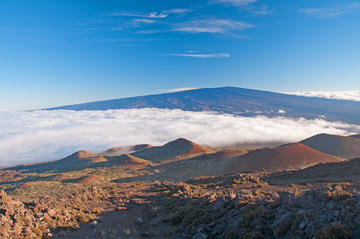Mauna Loa
TIME : 2016/2/22 16:51:42

Mauna Loa
The world’s most massive volcano doesn’t tower over Hawaii Island like you might expect. Instead, its giant three-pronged fingers consume most of the southern half of the Island reaching the sea in spots both north and south of Kailua Kona, across the Saddle Road interior and sloping down behind Hilo. It’s possible to be on the slopes of Mauna Loa and not even realize it! To get a true sense of the volcano most visitors opt to drive along the central Saddle Road, etched into the barren lava rock foothills where Mauna Loa meets Mauna Kea. If you turn in near the 28 Mile Marker on Mauna Loa Observatory Road, you’ll be rewarded with a 17-mile (one way) scenic drive up its slopes from around 6,500 feet above sea level to 11, 150 feet, ending near the entrance to mountain’s observatories. Unlike the astronomical observatories atop neighboring Mauna Kea, Mauna Loa’s observatories mostly monitor weather. It is possible to visit the observatories but prior arrangement is required. Additionally, a number of hikes around the Island explore Mauna Loa’s flanks and two challenging routes—a 13-mile day trip and a 30+ mile, three-to-five-day trip—will get your feet shuffling toward the summit.
Practical Info
Though currently not erupting (the last eruption was 1984), the volcano is still considered active. Mauna Loa is not prone to violent eruptions—instead it oozes lava toward the sea—but visitors should still be aware of the possibility of eruption and take appropriate precautions when visiting. A good resource for up-to-date eruption and safety information is the USGS’ Hawaiian Volcano Observatory (HVO): hvo.wr.usgs.gov. If you plan to go up Mauna Loa, or even just drive along the Saddle Road, note that elevation gain is significant. You should not go up Mauna Loa if you have recently scuba dived. If you have any signs of altitude sickness—weakness, trouble breathing, higher pulse—turn back to a lower elevation. It can be chilly at the top (it even sometimes snows!) so be sure to wear cold weather clothing if you plan to leave your vehicle.
Due to lack of staffing at the summit observatories, tours are currently only being offered on select Thursdays at 12:30 p.m. (though this could change). It’s best to reserve tour spots at least two weeks in advance by calling (808)933-6965 ext. 233.
To hike the longer Mauna Kea Summit Trail, advance permits are required through Hawaii Volcanoes NP. Along-the-route cabins restrict the trail to a maximum of 16 hikers at any given time so it’s best to reserve your permits in advance.
